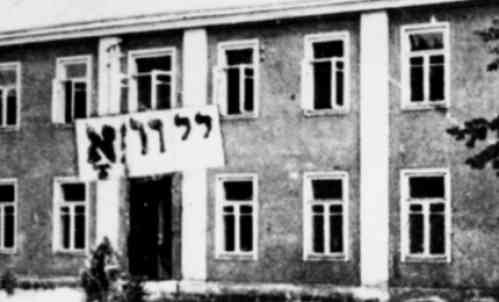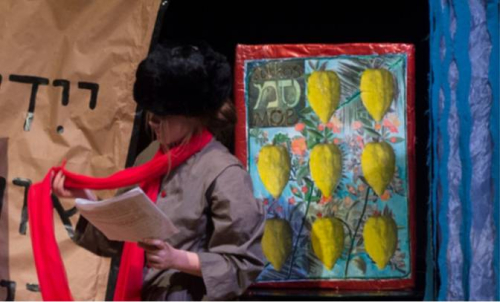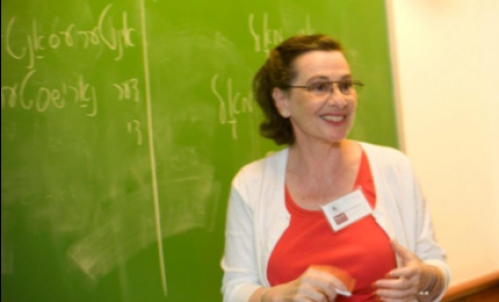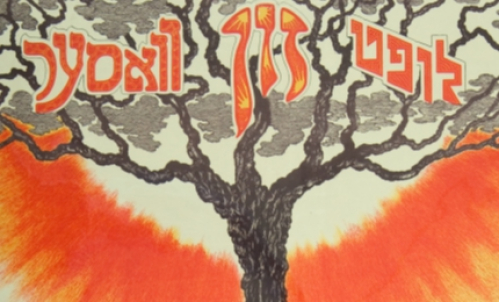Reconstucting the Past: Interview with Rick Brown
On Sunday, October 12, at 6:30pm YIVO presents “Making/History: Reconstructing the Gwoździec Synagogue,” about a ten-year project to rebuild the roof and ceiling of a 17th-century wooden synagogue for the Museum of the History of Polish Jews. “Making/History” features the project’s creators, Rick and Laura Brown of Handshouse Studio; Trillium Studios filmmakers with excerpts from their documentary, Raise the Roof; and project funder Irene Pletka.
Helena Gindi, Public Program Director at YIVO, and Rick Brown of Handshouse Studio sat down and spoke about the project, Handshouse’s educational philosophy (“learn by doing”), and why the Browns are in still in awe of Gwoździec. Highlights from their conversation appear below.
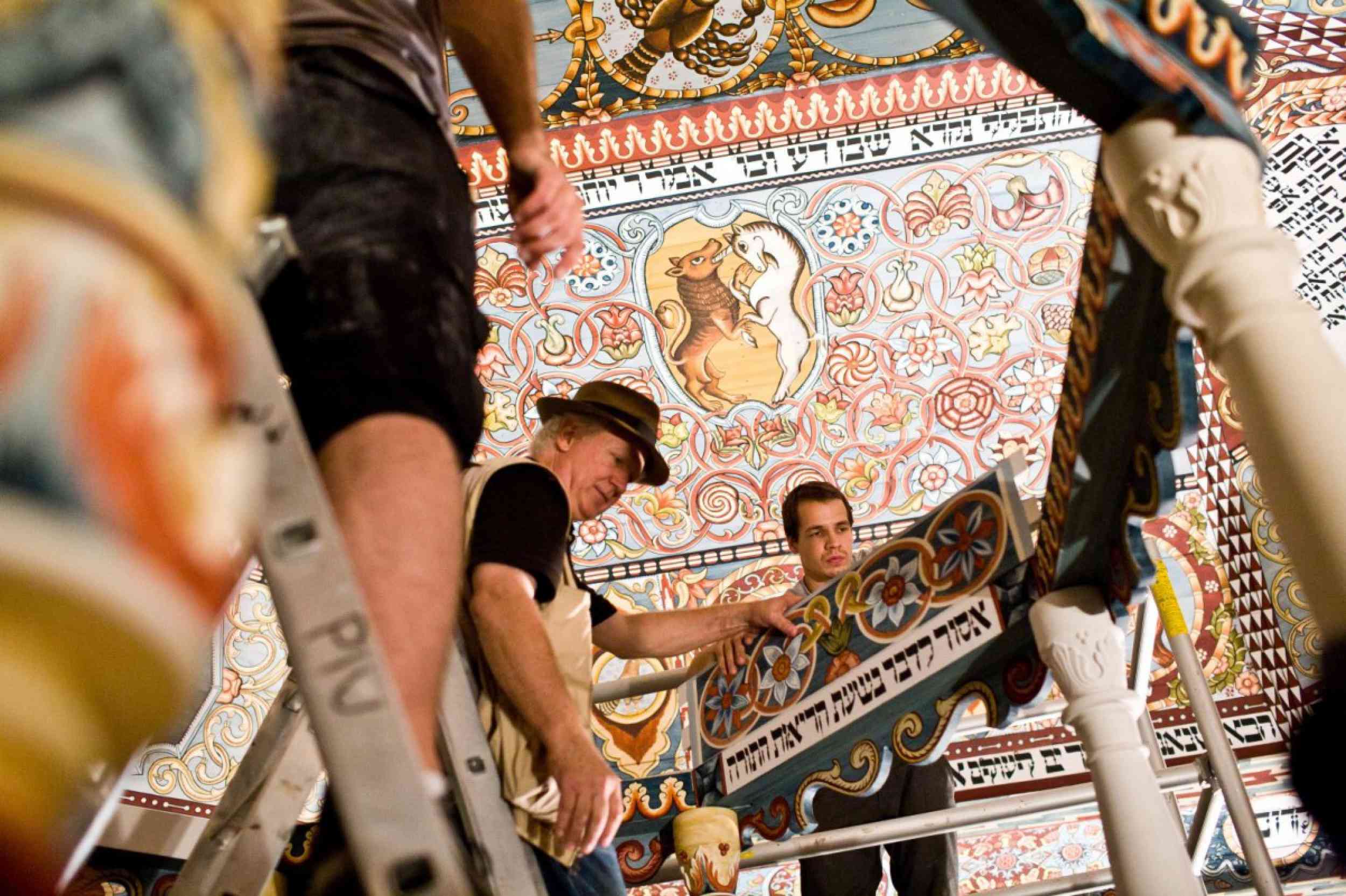 Rick Brown (center) positions a piece of the bimah in the newly reconstructed Gwoździec synagogue. Photo: Magda Starowieyska, Museum of the History of Polish Jews.
Rick Brown (center) positions a piece of the bimah in the newly reconstructed Gwoździec synagogue. Photo: Magda Starowieyska, Museum of the History of Polish Jews.Attend the event.
Watch the trailer for Raise the Roof.
HG: Let's begin with the Gwoździec synagogue 300 years ago. Describe what it would've been like to experience the synagogue. Beginning with the outside, and then walking in, what would we have seen?
RB: That’s an interesting question. First of all, from the outside, the synagogue had a real physical presence—the building seemed, in a lot of ways, visually, architecturally, quite powerful. It had a multi-tiered roof, sort of a pyramidal-like roof with wooden detailing on the outside. When you entered the synagogue, there was a women's entrance and a men's entrance: you’d go through the entryway, then through a door into the prayer hall, and at this moment, this is when you’d see a uniquely Jewish interior. And I imagine for anybody, it would have been a spectacular, inspiring, powerful moment to go from the outside to the inside, because as soon as you opened that door, you saw the bimah, which was in the center of the synagogue. And the bimah was a very elaborately carved and ornate raised platform, painted in brilliant colors, and also was quite tall—it was 17 feet tall from the base to the top.
Now, we believe Gwoździec was where they came up with this new idea of creating a very elaborate, multi-tiered wooden panel ceiling—we call it a cupola, and it moves upward and inward toward the top. And what this does is create a centralized architectural element (which is very appropriate for this synagogue because its bimah is in the center). This is where the synagogue was creating its own architectural identity separate from the Christian churches. See, the Christian churches were based on the basilica: a long, straight nave, this processional. You come up the staircase, you go through the doors, you go down the aisle, and you come to the altar at the end. In this synagogue, in Gwoździec, the bimah was in the center; this is where the Torah scrolls were brought during a service, this is where the rabbi would speak, and the congregation would move around the bimah in a kind of circular fashion.
HG: The seating was in the round?
RB: There's no seating.
HG: Oh, there's no seating…
RB: There's no seating, people are standing.
HG: And where are the women?
RB: Now the women… Imagine—the prayer hall is like a cube, that's the heart of the building, and the first thing that would be constructed. And then side, shed-like rooms and spaces would be added; in Gwoździec's case, on the outside of the prayer hall. That became the area where the women were—they would be outside the prayer hall, they would actually look through little slits in the wall to see into the prayer hall. They had a separate zone, which was the convention at the time.
HG: Going back to what you mentioned earlier…You said, the synagogue’s centralized character was uniquely Jewish, but we know that the wooden architectural structure itself was not. There were many Polish churches built; it was very much a Polish architectural tradition. Is it possible to divide the synagogue in terms of what was Jewish about it and what was not? Is this possible?
RB: Let me say that it’s difficult. For example, when we see unicorns painted in the Gwoździec synagogue, many people would say, well, that’s a Christian symbol. Our answer to this is yes, that’s a Christian unicorn, but what we’re looking at here is a Jewish unicorn. It’s really hard to say. An overzealous Christian would say, there’s the Jews taking a Christian symbol and trying to make it their own.
HG: But this isn’t how you see it.
RB: Symbol borrowing is rampant in all faiths. There are so many things that cross over. In the Christian faith, there are so many pagan symbols that Christians borrowed and made Christian. And over time they became identified as Christian, but they’re really coming from another way of thinking. It’s really hard to break those things down. I couldn’t say exactly how these liturgical influences, how these elements became part of the artistic, architectural, liturgical palate that was used. I’ll be ridiculous: were there ten rabbis from different communities who got together and said let’s add a unicorn to our painting? I don’t think so—these things evolve through some more complicated system. But it’s not willy-nilly, it’s part of the belief system. My feeling is that there was a very sophisticated, multicultural vision—and an informed Jewish community, who pulled these things into their realm because they felt that they were significant and should be part of their realm. The Gwoździec’s synagogue’s ceiling includes unicorns, it includes the North American turkey, a gryphon fighting a dragon… They’re borrowing from folk art, Eastern traditions, a wide range of influences. And that’s being manifested into this thing that became a uniquely Jewish art form.
Let me give you an example. When we studied the paintings, we’d go to the Christian churches, and there, the paintings are all narratives: the stations of the cross, the different Bible stories. The paintings on the wall seem to have a spontaneity, whereas the paintings in the synagogue are not narrative: they’re pictorial and symbolic and not introspective. They are very flat, like silhouettes. And so as an artistic style, we can say that this is where this Jewish phenomenon was very unique. Paper-cutting has a long history among Jews. From earlier in Western Europe, in Italy and Spain, it moved east to Poland. The paper-cut as a process is: you’d fold a piece of paper, you’d draw an image, cut it, open it up and it’s symmetrical, a flat plane. And in that flat plane you have lines and flowers. If you look at these paintings, they look like the paper-cut motifs. This is my own personal idea, I’d like to be able to make a good thesis about it—I believe this is how these painters began. They probably used paper-cuts as a way of laying out this thing architecturally and using certain symbols as a form to begin to design this ceiling. But in the Christian churches, they’re not working like that at all. It’s somebody who’s laying out a narrative; it’s a completely different path to generating images. At Handshouse, one of the things that we do is we replicate objects as a way to understand history, culture; it’s more than just “how to.” One of the things that we know, having spent a lifetime as makers, is if you use a certain technique, a certain tool, it’s going to take you down a specific path. A tool acts in a certain way, and if you’re trying to understand a culture, and we say “we don’t have that tool, we’ll just use this 20th-century tool,” it’s going take you down a path that will lead you away from that culture.
HG: Right, and you actually used the same tools these builders used 300 years ago.Tell me, how did using these tools lead you down a path? Where did they lead you?
RB: So, lets’go from England to France, to Germany, to Poland, to Japan, and you pick the same time period. Say they’re building a temple in Japan and a Catholic church in England and a synagogue in Poland—they’re going to be using axes as their tools, but what you’ll find is that the shape of the axe is different. That might sound unimportant, but the truth is that people, craftspeople, develop techniques that become a culturally specific. A German timber framer would use an axe so that when they’re hewing a log, they go from back to front. An English carpenter would go from front to back. In Eastern Europe, they developed joinery that was based on using an axe, it didn’t require a chisel.
HG: You’re saying that the culture itself is embodied in the way we make and use objects.
RB: Making is like a language. It has its unique ways that you construct a sentence. If you try to translate a Japanese haiku into English, a lot is lost. Because the language is so different. But you could see something in English and Hebrew, in these languages, and say this is Jewish because it has a certain kind of uniqueness about it. Barbara Kirshenblatt-Gimblett [Program Director, Core Exhibition at Museum of the History of Polish Jews] and I were going around the other day; we’re writing a museum catalogue. We’re going around because I was saying how we were in this part of our process where we’re making the ceiling’s flowers—500 flowers—consistent. In this workshop we told the students, take this flower and go over there….they were working individually making these objects, and we did this several times, and said, this just isn’t working. The flowers didn’t come together compositionally, they were done differently, and so we said okay, we want everybody working on the same table, doing the same flower, using the same paintbrushes, establish the technique together. And as I back up, I say, oh my gosh, what we were doing originally was a 20th-century way of working, artist as individual, all on your own. When you come together and work shoulder to shoulder, using the same techniques, that’s a medieval workshop system. Laura and I are convinced that these two painters were not acting alone. They were using the medieval workshop system. It takes a lot of people to mix these paints every day. It takes people who are laying out the work, and because the paint’s very sensitive, you have to apply it at a certain temperature. If it’s too hot the color changes, it flows differently. So over the years, we concluded that this painting was done in a medieval workshop system. This painting is so labor intensive and sophisticated. I’m convinced that they had to use this medieval workshop style.
This is how Michelangelo painted the Sistine chapel. This is what the studios were like then, and that continued up through the 18th century. In some situations, it’s still used. And we gleaned this information by trying to do what they did exactly, so it starts to categorize itself historically. It’s not a modernist technique; it’s really a medieval style. That starts to help us… It’s a way of working. I’m sure you’ve seen stories about Michelangelo’s studio where there are a lot of craftspeople of different levels, up to the master—and these Jewish painters would have been the masters—making this thing possible. That’s how this was done. I’m pretty confident it was done in the synagogue.
But that starts to help you visualize what it was like in 1715 in a small town: this was a very sophisticated process. And it continued throughout this region. This was not just these two painters. A number of these synagogues flourished at that time.
HG: This leads into one of the questions I have for you. Last year, you were quoted in the Boston Globe, as saying: “By looking closely at the historic object and trying to build it as accurately as possible, you inevitably learn about the social, political, and economic forces that were present at the time.” What does this synagogue teach us about how those Jews lived? Or who they were?
RB: Yes. Let me begin by talking about Tom Hubka. His grandfather's Polish, he's not Jewish. He's an architectural historian at the University of Wisconsin, who spent 15 years researching, and he put together a book specifically about Gwoździec.
Now, I have a lot of Ashkenazi Jewish friends in this country. None of my friends, none of them, knew about this history. This is what the Nazis wanted: they wanted to destroy a people, and the history of their culture. And they were systematic and they were almost successful. A lot of information was lost. What Tom says in his book—and respectfully, because he takes this subject very seriously, and he's careful not to be offensive—what he says is that the general attitude in America about Poland and the Polish Jew is that they lived in impoverished shtetls, and had a horrible existence in Poland. And he says, well, this isn’t true. He says part of what made this myth popular was Fiddler on the Roof—the film planted in people’s minds this sort of horrible living condition for Jews in Eastern Europe. But he says these synagogues were not, could not have been, made in that kind of environment. And this is the point: these synagogues were made in a time when the Jews were actually quite prosperous. In most of these market towns, forty, fifty, sixty percent of people in the town were Jews. And they lived a wonderful life. In Eastern Europe and in Poland, the Jews were creating incredible educational institutions. They were writing and making plays, and writing books and making music, and there was a very vibrant creative culture in Poland. And it wasn't there for a short period of time. It was there over a thousand-year period. They'd lived there for a thousand years.
But his point is that these synagogues, in this genre, were not made by a local artist with a localized idea. These were made with liturgically influenced, well-established ideas about art and architecture. They evolved in this region over a long period of time. These were sophisticated synagogues, and examples of world art and architecture, and should be perceived that way. Not as folk art in little, impoverished towns.
And we know all this from the architecture. The synagogues had square plans. They also had these very elaborate roof structures, these multi-tiered roofs, and they had these very complex, multi-tiered wooden panels. The roof structure had to hold itself up. It had to also hold and suspend these roof panels and make these great spans. So our conclusion is that these things were incredibly sophisticated engineering projects. This is not something that is, again, just some local carpenter building these things. They're probably bringing in some very highly skilled timber framers who have the experience designing and pulling off these architectural feats. And so, when we take a close look at these buildings we say, "This is not just somebody just slapping together a building. This is highly sophisticated work." What are the social, political, economic forces that are making this happen? For us, this dispels this notion that Jews were living in an impoverished and unproductive way.
HG: For me, a lot of what you just said brings up Handshouse’s methodology and your mission: “learning by doing.” Now, people use that phrase a lot, but don’t really mean it. Because if you think about the way we learn in school, it’s learning through study, it’s a very intellectual process. We don’t really respect the idea of learning by doing. How did you come to your mission? How did it evolve?
RB: First of all, in my lifetime, I’ve always been attracted to making. It’s the physicality of making. That’s just been part of my makeup my whole life. I loved school, but I wasn’t an academic student. I could do it but I wasn’t attracted to it.
Laura and I met when we were in college. We immediately became best friends and married. She didn’t grow up as kind of a maker, but she had these tendencies, and together we nurtured this joy we had in making things. But I also always believed that if I read a book about the African drum, it’s inspiring, but if I make an African drum, it does something else for me. So we have this passion for making, and over the years, we have made a lot of things. We did all kinds of forms of woodworking, carpentry work, furniture, boat building; we made all kinds of historic objects, and because we’d been in art school and teaching, we met many craftspeople, and we have kind of a repertoire, a group of people all over the world that are makers.
And so we evolved into working entities—we call it the dynamic learning environment. Let’s take something like the human-powered crane—this large wooden timber crane, a wheel that people get into like a hamster cage. It’s used for lifting. We found evidence of this that went back to 1st-century Rome. Nobody knew about it; it fell out of the known realm in history. So we thought, let’s build this object.
And so what we do is we start to research. We’ll put a picture on the wall at school and say, how would you like to build this? Sign up for a class next semester. And people will stand in line to do it. And then the first day of class we’ll look at a 15th-century painting of a Belgian merchant and above his head is a little image of a crane, and we ask, how do you use it, what’s it made of? Why is it in a painting with a Belgian merchant? There are all these avenues of inquiry. So we say, let’s build some models. What materials did they use? Then you get to a point where you say we’re knowledgeable enough to build this thing full-scale because we’ve informed ourselves a little bit by observation, and by looking at resources. Then we hold a workshop, bring in 25 professional timber framers, and fifty students, and we ask, how do we start? And somebody says, I can lead a team on how to make the wheel, I can do hewing, and so you start the process and four days later you have a 50-foot crane, and it’s like a mythic journey; it’s like crossing the Atlantic in a sailboat. It’s so memorable and so powerful. It’s like high adventure. It’s like we’re going to sail to the other side of the world, and then on the way there are all these amazing experiences you never expected to have. Because if I had put on the wall, “how would you like to learn about the history of France in 1750?,” nobody would have come. But at the end, they built this crane, and now they know about the history of France in 1750.
It’s such a dynamic way to learn that this is where I think that most times when people try to attempt “learn by doing” in classrooms, they’re not looking at it comprehensively. Their target is not as monumental, and monumental becomes inspiring. People walk away saying I can’t believe we got that done in 4 days. Then, they want to come back again.
HG: Let’s end by talking about the installation in the museum itself, in the Museum of the History of Polish Jews. The replica is part of the Museum’s core exhibition which is scheduled to officially open on October 28. Describe how visitors experience the installation. What do they see first?
RB: First of all, Laura and I are sculptors. We still have sculpture careers on the side, and we’ve always done large environmental installations. And so, in some ways, this project is a lot like a large-scale sculptural installation. Because when you come in the building, it’s a spectacular piece of architecture—you come up this ramp, you come into this space, and the first thing you do is, you turn right into this big open area, and you see the synagogue roof structure, penetrating up through the floor. And you see the roof structure behind a glass box, and the contrast of that 17th-century, wooden, hand-hewn structure against the backdrop of this very modernist museum is so elegant, so spectacular.
And as you approach that box, you can look down inside and you see that it’s the top of the building. You see down inside and see the complexity of the roof structure, and the backside of that Italian baroque vaulting—which nobody would ever have seen historically, but the viewer gets to see this, and it’s so visual, and so alien in a way, you get a really good sense about the complexity of this Polish Jewish structure. Then you’re going to go and follow a prescribed path, downstairs, the journey through the history of the Jews in Poland, and you’re going to go through a number of galleries before you arrive underneath our synagogue. But when you enter that room, you see this thing, and I think you instantly make the connection of the top to the bottom, but you see the painting—which is just so gorgeous, so powerful—and the bimah. For ourselves, we still don’t even know how to verbalize what we’ve done and the experience we’ve had and what this thing is. But it’s simply so beautiful.
We built the bimah here as one of our workshops, and we thought it was so important that they have the bimah there, on the floor, because you don’t have the walls of the synagogue, and so the bimah becomes also a gorgeous object. It connects the ground to the top of the vaulting. It’s a nice dialogue of the earth and the heavens. The painting is so elaborate, has so much information. You can stand there and spend a long time taking in all the different elements: the animals the flowers, the Hebrew text, color. But I think what it does is that because it is sort of alien, sort of sculptural, and it doesn’t have walls, it becomes an object that really sticks in your mind. And I think for most people who go through the whole experience, this is the image that will stick in their mind when they leave: the synagogue as a representation of a brilliant, creative culture.
We feel lucky, like we were at the right place at the right time. That sounds kind of corny, but we were given an opportunity to do this. And it’s so much bigger than ourselves, so we feel that we were very lucky to have the opportunity. You know, we found a lot of opposition among our Ashkenazi Jewish friends and scholars: they’d say, “Poland, that’s your project.” We understand because there’s no way to even describe the loss for Ashkenazi Jews and what happened in the 20th century, it’s just so painful. Maybe this hasn’t been researched and other Jews haven’t done this work because it was just too loaded with pain. You know, there’s a synagogue where we spoke about the project, and afterwards, the rabbi called us and said that most of the people in their congregation have little or no interest in Poland, but now that they’ve seen this, they’re going to invite their whole congregation to go to Poland together. We’re so happy that this will invite and encourage so many Ashkenazi Jews in America to go back to Poland to visit their homeland and to reconnect with their creative, poetic history.
Interview transcribed by Alix Brandwein and Leah Falk, and edited for length and clarity.
